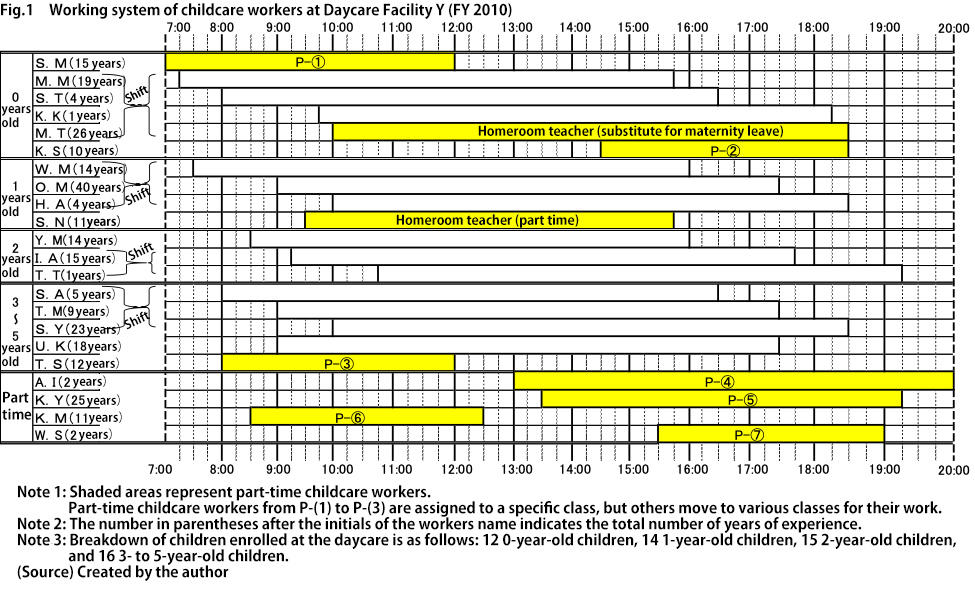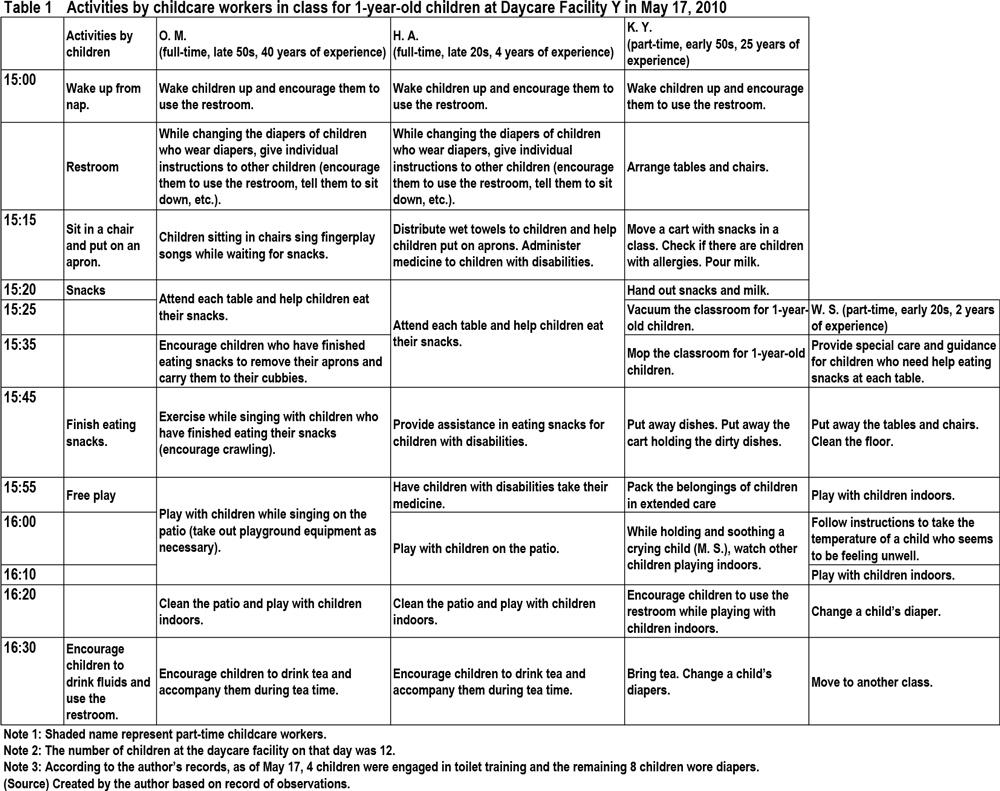Necessary Measures to Prevent the Recurrence of Accidents at Childcare Facilities and the Problem of Inappropriate Childcare
〜 From the perspective of workplace structure for childcare workers 〜
Harumi Obi/Assistant Professor, Faculty of Economics, Chuo University
Areas of Specialization: Social Policy and Labor Sociology
Assessing the problem of inappropriate childcare
There have been a series of cases of inappropriate childcare (children dying in accidents, being abused, etc.) at daycare facilities. Such accidents and inappropriate responses are serious problems that deeply hurt the victimized children and inflict great anxiety on their parents. In order to prevent recurrence, it is necessary to properly verify why such incidents occurred and how daily childcare was performed. In this article, I would like to examine the problem of workplace structure for childcare workers as one element in discussions on how to understand and solve the problem of inappropriate childcare.
In March 2021, the Ministry of Health, Labour and Welfare (MHLW) compiled the Guidelines for Preventing and Handling the Occurrence of Inappropriate Childcare. These Guidelines established the concept that "each childcare worker must verify childcare which respects the human rights and character of children, identify interactions which are in conflict with the spirit of such childcare, and share such knowledge among all workers" as the most important effort in preventing inappropriate childcare. Measures to prevent inappropriate childcare are fundamentally positioned as problems that can be resolved based on correct understanding by individual childcare workers, managers, and supervisors of each facility. On the other hand, although importance is given to the elements of sufficient time and emotional leeway and workplace environment among childcare workers, the Guidelines make no reference to the importance of improving the workplace environment or working conditions of childcare workers; for example, adjusting the number of assigned childcare workers, class size, or workload.
The situation of childcare for preschool-age children has changed significantly in Japan over the past 20 years. For example, in 2000, 24% percent of all children under the age of three (such young children relatively needs a lot of attention) were enrolled at daycare facilities. However, this ratio has now reached about 40%. Furthermore, the hours of daycare facilities are growing longer in response to the expanding need for extended childcare. In 2000, 8,939 daycare facilities (approximately 40% of the total number of facilities) were open for more than 11 hours. In 2020, this ratio had grown to 23,814 facilities, which is approximately 80% of all facilities (according to the Survey of Social Welfare Institutions by the MHLW). Nevertheless, over the past 20 years, there has been no change in the standards for assignment of childcare workers, and barely any change in amount of expenses per child that the government pays to childcare facilities (the basic unit price authorized by the government).
What kind of work is done by childcare workers?
Contents of duties and workplace structure
As mentioned above, the opening hours for many childcare facilities are currently 11 hours or more. Still, in principle, the Labor Standards Act stipulates that the working hours of childcare workers must not exceed 8 hours per day. Childcare facilities handle this discrepancy by using rotating shifts to operate over 11 hours per day. The following examines the daily operation of childcare facilities and the work duties of childcare workers based on observations made at Daycare Facility Y (in 2010), which is a licensed private childcare facility located in a certain ward of Tokyo.
Daycare Facility Y is a childcare facility with 89 enrolled children (from 0 to 5 years old) and 40 staff members (including 28 childcare workers). Daycare Facility Y operates for 12 hours and 45 minutes per day, from 7:15 a.m. to 8:00 p.m. Figure 1 shows the weekday work shifts of childcare workers at Daycare Facility Y by class.

At Daycare Facility Y, full-time childcare workers are assigned during the hours from 9:00 a.m. to 4:00 p.m. During this time period, the main work duties are performed in class groups with a large number of children. On the other hand, Figure 1 shows that the majority of part-time childcare workers work shorter hours during time periods when there are fewer children and full-time childcare workers. In other words, it is evident that normal operation of a daycare facility is not possible by using only full-time childcare workers; instead, it is only possible by hiring part-time childcare workers to cover the additional working hours. Figure 1 also shows how childcare workers all work slightly different hours and report to work at different times. Therefore, each time that a different childcare worker arrives at the daycare facility, it is necessary to communicate and share various information and policies which must be known in order to work that day. In particular, information exchanged with parents includes health-related matters such as allergies and illness, and as well as matters related to family privacy which can affect the emotional status of a child. Failure by childcare workers to correctly handle such information will directly affect the emotional and physical safety of the child and may lead to serious problems. For childcare workers, a workplace environment that guarantees information sharing and collaboration with coworkers is of the utmost importance for protecting children's safety and providing high-quality childcare.
In particular, infant care for children from 0 to 2 years old requires multiple childcare workers to spend time with multiple children in the same space at the same time. Children move in unpredictable ways, which can easily lead to accidents if appropriate response is not taken immediately. Childcare workers are unable to complete work procedures at their own pace; instead, they must work in harmony with their colleagues while flexibly adapting to the movement of children. Here, I would like to introduce an example of a class for 1-year-old infants at Daycare Facility Y.
Table 1 shows how childcare workers are involved in the flow of children's daily activities from 3:00 p.m. to 4:30 p.m., after a nap. When examining the activities of childcare workers, it is apparent how they continuously and comprehensively observe the movements and state of the infants as a group and cooperate with their coworkers in their duties to ensure the smooth flow of the children's activities while giving individual attention to infants as necessary. For example, the full-time childcare worker O. M. serves as leader of the children's activities while constantly assisting individual infants. H. A backs up O. M. by also being involved in the children's activities and assisting children in transitioning smoothly to the next activity. On the other hand, Figure 1 shows how the part-time childcare workers K. Y. and W. S. back up the full-time childcare workers by handling tasks such as cleaning and serving meals, while providing guidance and assistance to children in their daily activities.

As described above, the duties of childcare workers can only be performed through harmonious work among coworkers during the same time period, as well as frequent exchange of information on matters such as the status of children and work methods. Therefore, the teamwork and the form of the workplace group has a very important meaning for the performance of duties by childcare workers.
Background of inappropriate childcare as viewed from workplace structure of childcare facilities
The environment surrounding childcare facilities in recent years is making it difficult to realize the sufficient cooperation, skill development, and other functions of workplace groups consisting of childcare workers. As already discussed in this article, the first point which must be pointed out is the complexity of work shifts due to long hours of operation. The current work system consists of arranging just enough childcare workers in order to support long hours of operation. This kind of work system makes it difficult to share information, coordinate shifts, and collaborate with other childcare workers. Research has shown that shift work increases the difficulty of sharing information and cooperation. Specifically, it results in more time being spent on meetings and recordings to ensure continuity of care than on actual involvement with individual children. Furthermore, there are cases in which the burden on full-time childcare workers increases and they lack time for sufficient communication with coworkers. In other cases, part-time childcare workers do not receive sufficient opportunities to learn from their supervisors, superiors, or coworkers, and do not have the chance to share their opinions.
One reason for the occurrence of childcare accidents and inappropriate childcare is that a sufficient number of childcare workers is not assigned according to the hours and days of operation at childcare facilities. The official price paid by the Japanese government to childcare facilities is based on the number of childcare workers who provide 8-hour childcare on the premise of a 40-hour work per week. However, childcare workers also have duties such as clerical work consisting of meetings and document preparation. In practice, due to having children at the facility for more than 8 hours and to providing childcare on Saturdays, childcare facilities must allocate more staff than those covered by government benefits, or childcare workers are forced to work unpaid overtime.
Since incidents of inappropriate childcare started to become widely publicized, accidents and abuse at childcare facilities, etc., throughout Japan have been covered by various media and have become scrutinized by the public. Content aimed at improving staff standards for childcare facilities, etc., was included in the policy draft of the Children's Future Strategy Council (an organization established by the Cabinet Office) on June 1, 2023. Improvements to standards for allocating childcare staff had been requested for a long time, and the inclusion of specific response in the policy draft will have an immense impact. The Japanese government must increase the number of human resources at childcare facilities who can support the development of children and the employment of parents, and must ensure staff allocation and working conditions that enable stable training of childcare workers.
[Reference Literature]
・Harumi Obi (2014), Impact of Transformation in Childcare Labor on Childcare: From an Analysis of Job Duties of Full-Time and Part-Time Employees, Gendai to Hoiku (89), pp. 21-37.
・Harumi Obi (2016), Transformation of Workplace Groups for Childcare Workers and Issues for Improvement, Digest of Science of Labor 71 (10), pp. 11-15.
・Takako Tsutsui, Masaaki Otaga, Sadanori Higashino, and Fumiharu Yamagata (2012), Care Provided in Children's Self-Reliance Support Facilities: Using Time Study to Compare Care Provided by Couple in Small Units and Care Provided by Shift-workers, Japanese Journal of Social Welfare Vol. 53, No. 1, p. 36.
Harumi Obi/Assistant Professor, Faculty of Economics, Chuo University
Areas of Specialization: Social Policy and Labor SociologyHarumi Obi was born in Hokuto City, Yamanashi Prefecture. In 2008, she completed the Master’s Program in the Graduate School of Economics, Chuo University. In 2015, she completed the Doctoral Program in the Graduate School of Economics, Chuo University. She holds a PhD in economics (Chuo University). She served as a Full-Time Lecturer in the Faculty of Health and Welfare Science, Nayoro City University before assuming her current position in 2019.
Her areas of expertise are social policy and labor sociology.









